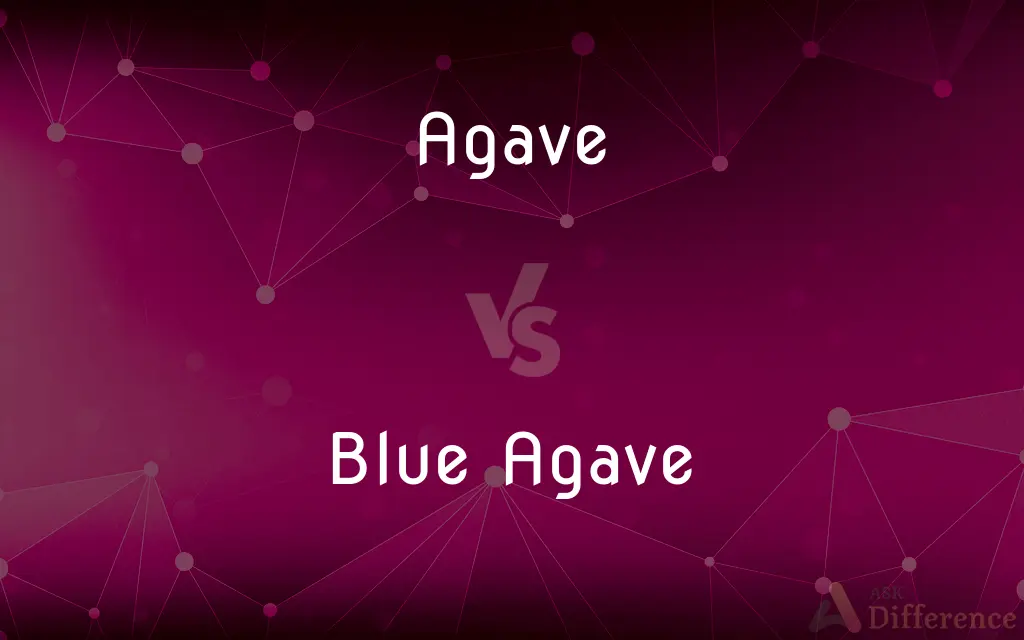Agave vs. Blue Agave — What's the Difference?
Edited by Tayyaba Rehman — By Fiza Rafique — Published on December 24, 2023
Agave is a genus of succulent plants native to hot and arid regions; Blue Agave refers specifically to Agave tequilana, the primary plant used to produce tequila.

Difference Between Agave and Blue Agave
Table of Contents
ADVERTISEMENT
Key Differences
Agave is a versatile term in botany, representing a vast genus of succulent plants. These plants are characteristic of hot and arid regions, primarily found in the Americas. Agaves are renowned for their rosette of thick, fleshy leaves, and many species have sharp marginal teeth and a terminal spine. Some Agave species, like the Agave americana, have been used for various purposes, such as ornamental plants or for producing fibers.
Blue Agave, scientifically known as Agave tequilana, is a species within the Agave genus. Its "blue" descriptor is attributed to the silvery-blue hue of its leaves. This particular Agave is most notable for its role in the alcohol industry. It serves as the primary plant used in the production of tequila, a traditional Mexican spirit.
The general term Agave encompasses many species, with each having its distinct characteristics and uses. While some Agaves are employed for ornamental purposes or their fibers, others, like the Blue Agave, have culinary and beverage significance.
Blue Agave stands out within the Agave genus due to its association with tequila. Only spirits made from Blue Agave, specifically from certain regions of Mexico, can be labeled as tequila. This distinction has given the Blue Agave a unique cultural and economic value.
In essence, while all Blue Agaves are Agaves, not all Agaves are Blue Agaves. The differentiation primarily rests on their appearance and utilization, especially in the context of tequila production.
ADVERTISEMENT
Comparison Chart
Species Variety
Encompasses many species
Refers to Agave tequilana specifically
Coloration
Varies, not all are blue
Silvery-blue leaves
Primary Use
Ornamental, fibers, some beverages
Primarily for tequila production
Geographic Distribution
Found across the Americas in arid regions
Predominantly in certain regions of Mexico
Economic Value
Varies depending on species
Highly valued for tequila industry
Compare with Definitions
Agave
A genus of succulent plants native to hot and arid regions.
The Agave plant thrives in desert environments.
Blue Agave
An Agave with distinct silvery-blue leaves.
The shimmering leaves of the Blue Agave give it a majestic appearance.
Agave
A plant often used for ornamental purposes.
The unique appearance of the Agave makes it a favorite among gardeners.
Blue Agave
The primary ingredient in certified tequila production.
Without Blue Agave, one cannot produce genuine tequila.
Agave
A source of fibers for various traditional uses.
Agave fibers were once commonly used to make ropes.
Blue Agave
The specific Agave species used predominantly to make tequila.
Authentic tequila is distilled from the sap of the Blue Agave.
Agave
A plant known for its rosette of thick, fleshy leaves.
The Agave's sharp leaves can be a hazard if not handled with care.
Blue Agave
A plant indigenous primarily to certain regions of Mexico.
Jalisco in Mexico is known for its extensive Blue Agave plantations.
Agave
A plant with potential therapeutic or culinary uses.
Agave nectar is a popular alternative to traditional sweeteners.
Blue Agave
A highly valued species within the Agave genus.
The demand for tequila has elevated the worth of the Blue Agave.
Agave
Any of numerous plants of the genus Agave, native to hot, dry regions of the Americas and having basal rosettes of tough, usually spiny-margined leaves. Agaves are grown for ornament, fiber, and food. Also called century plant.
Agave
A plant of the genus Agave, which includes the maguey or century plant (Agave americana), which produces a gigantic flower stem at maturity.
Agave
A genus of plants (order Amaryllidaceæ) of which the chief species is the maguey or century plant (Agave Americana), wrongly called Aloe. It is from ten to seventy years, according to climate, in attaining maturity, when it produces a gigantic flower stem, sometimes forty feet in height, and perishes. The fermented juice is the pulque of the Mexicans; distilled, it yields mescal. A strong thread and a tough paper are made from the leaves, and the wood has many uses.
Agave
Tropical American plants with basal rosettes of fibrous sword-shaped leaves and flowers in tall spikes; some cultivated for ornament or for fiber
Common Curiosities
Is every Agave plant a Blue Agave?
No, only the Agave tequilana species is referred to as Blue Agave.
What makes tequila from Blue Agave special?
Only spirits made from Blue Agave in certain Mexican regions can be labeled as tequila.
Which Agave is most valuable for the alcohol industry?
Blue Agave is the most valuable due to its role in tequila production.
Can you make tequila from any Agave plant?
No, authentic tequila is made specifically from Blue Agave.
Are all Agave plants used for beverage production?
No, while Blue Agave is used for tequila, not all Agave species are used for beverages.
Are Agaves cacti?
No, though they resemble cacti, Agaves are succulents but not cacti.
Do all Agaves flower?
Most Agaves flower once in their lifetime, after which they typically die.
Is Blue Agave nectar healthier than regular sugar?
Blue Agave nectar has a lower glycemic index but should be consumed in moderation like any sweetener.
How is Agave nectar produced?
It's derived from the sap of the Agave plant, which is filtered and heated to break down the carbohydrates.
Why is Blue Agave blue?
The "blue" descriptor comes from its silvery-blue hue of leaves.
How can you tell an Agave from a cactus?
Agaves have leaves with a fleshy texture, while cacti typically have spines and a harder surface.
What products, besides tequila, can be derived from Agaves?
Agave nectar, ornamental plants, and fibers are among the products derived from Agaves.
Are Blue Agaves endangered?
Due to high demand for tequila, there are concerns about overharvesting, but they aren't classified as endangered.
How long does it take for a Blue Agave to mature?
Typically, it takes 7-10 years for a Blue Agave to mature and be ready for harvest.
Can Agaves be grown in any garden?
While Agaves prefer arid climates, many species can adapt to different conditions if properly cared for.
Share Your Discovery

Previous Comparison
Batch Culture vs. Continuous Culture
Next Comparison
Vitamin B6 vs. Vitamin B12Author Spotlight
Written by
Fiza RafiqueFiza Rafique is a skilled content writer at AskDifference.com, where she meticulously refines and enhances written pieces. Drawing from her vast editorial expertise, Fiza ensures clarity, accuracy, and precision in every article. Passionate about language, she continually seeks to elevate the quality of content for readers worldwide.
Edited by
Tayyaba RehmanTayyaba Rehman is a distinguished writer, currently serving as a primary contributor to askdifference.com. As a researcher in semantics and etymology, Tayyaba's passion for the complexity of languages and their distinctions has found a perfect home on the platform. Tayyaba delves into the intricacies of language, distinguishing between commonly confused words and phrases, thereby providing clarity for readers worldwide.











































